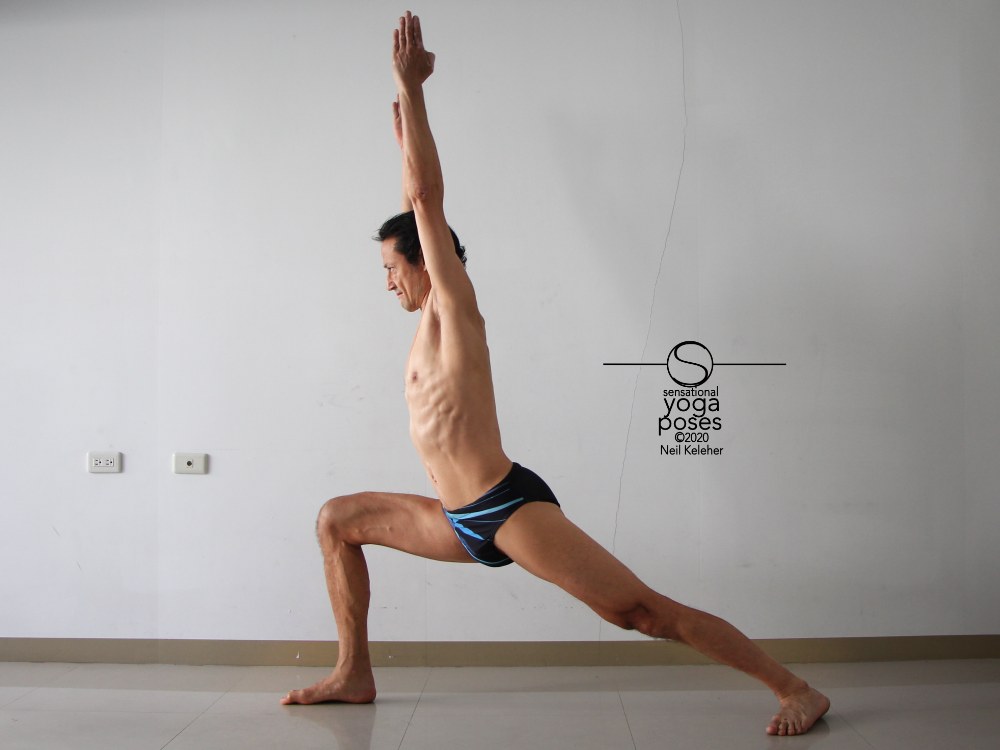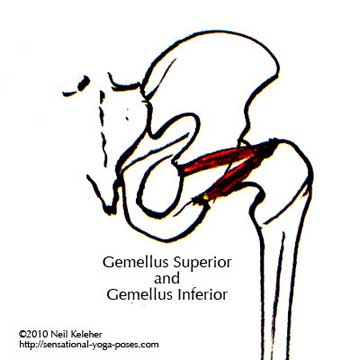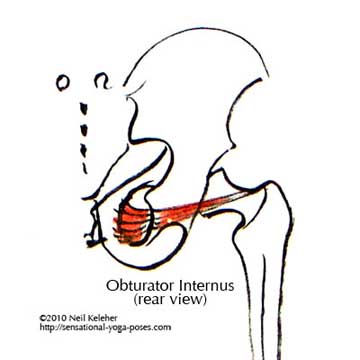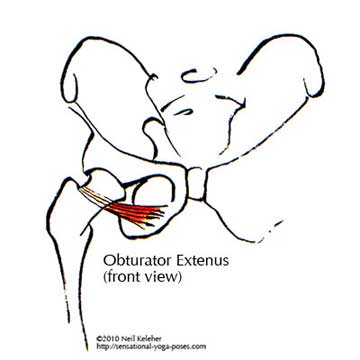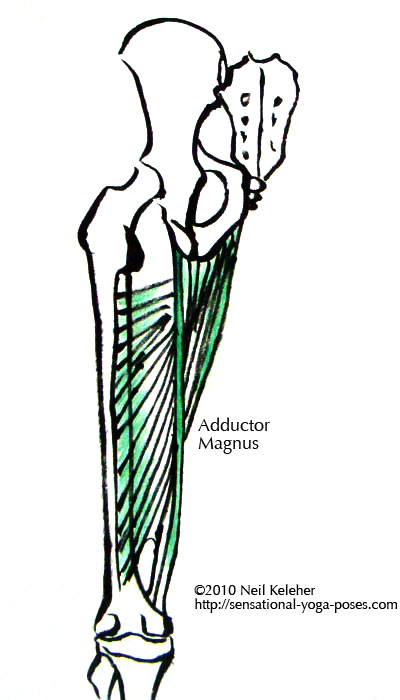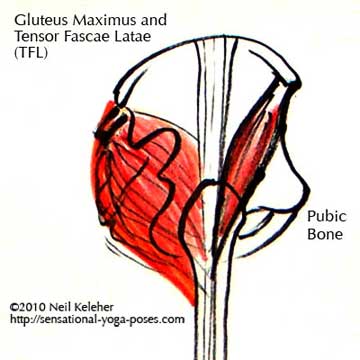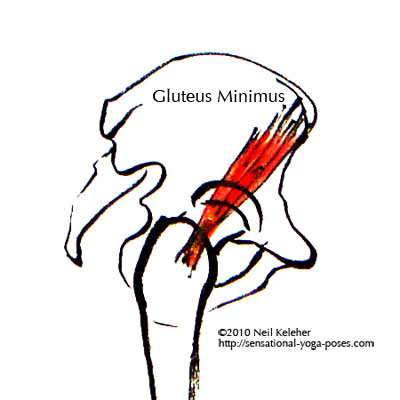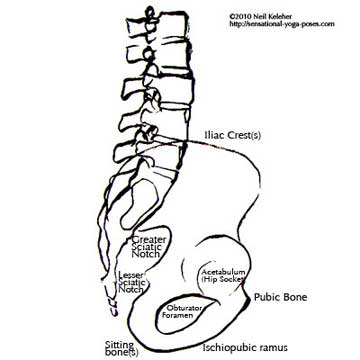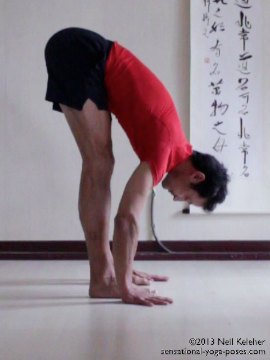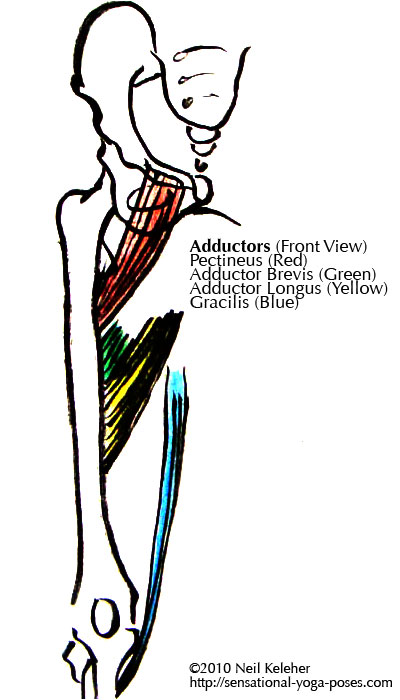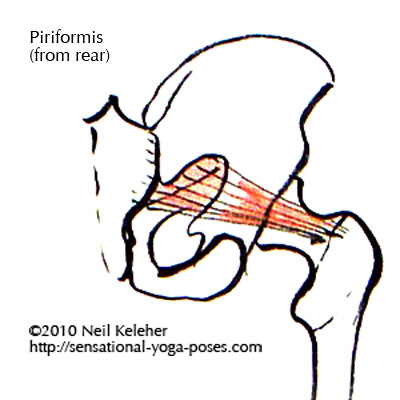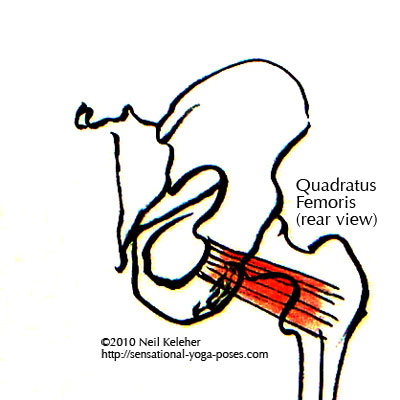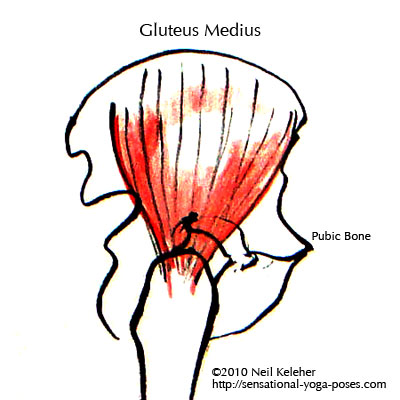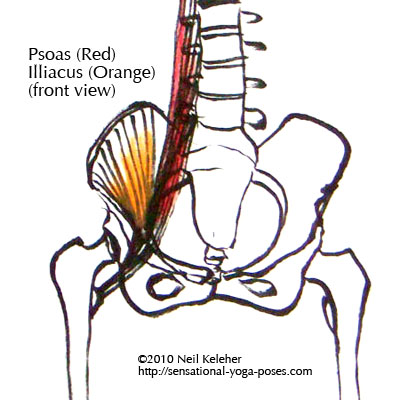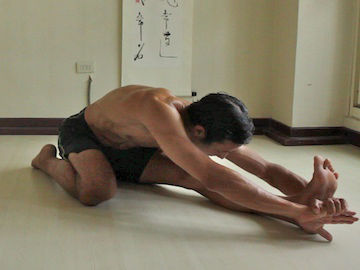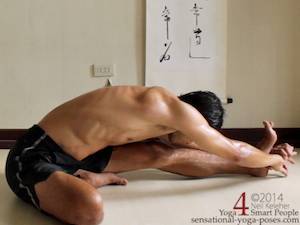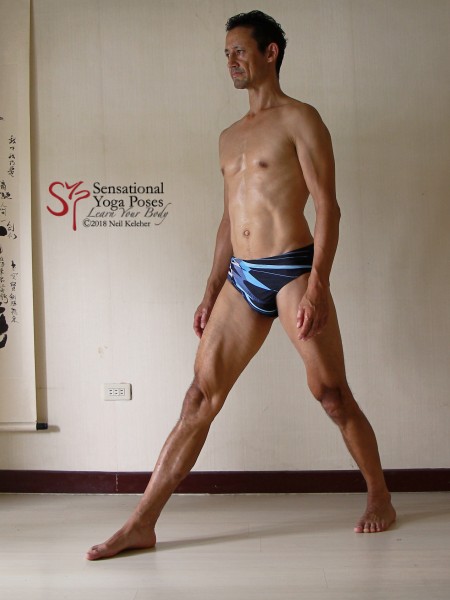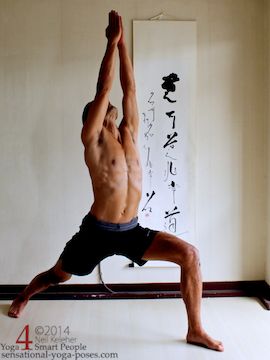Adjusting hip stability for proprioception and lubrication
Hip Joint stability for Increased Mobility and Control
keeping the hub of the hip joint centered
Using the hip rotators to stabilize the hips
Single leg exercises: Find hip problems and fix them
Low Back Pain Fix: hip bone stability while balancing on one foot
A proprioceptive reference for better hip awareness and control
Creating space in your hip joint generally uses the:
- Gemellus Superior,
- Gemellus Inferior,
- Obturator Internus and
- Obturator Externus.
When standing these muscles can be used to lift the pelvis off of the thigh bone. The movement is slight but it can be enough to help center the ball in the hip socket, countering the weight of the upper body on the hip joint.
Gemellus means twin, possibly with respect to the fact that they do look a little alike.
Obturator refers to the fact that this muscle covers the hole at the bottom of each side of the pelvis. These two holes are called the "obturator foramen."
Note that all of the above muscles can act to externally rotate the hip (as well as to help "lift" the hip bone.)
The gemellus superior attaches to the pelvis above the "lesser sciatic notch."
The gemellus inferior attaches below it.
The obturator internus attaches to the inside of the bottom of the pelvis (at the obturator foramen-the holes at each side of the bottom of the pelvis), but emerges from the pelvis between the two gemellus muscles.
The obturator internus and gemelli hip muscles leave the pelvis just above the sitting bones and reach "upwards" and "forwards" to connect to the back of the top of each thigh bone.
When these muscles activate, it may feel like you are spreading your sitting bones, particularly when the thigh bones are stable.
Together, these muscles can be used to pull your pelvis upwards relative to the thigh bone bones. (You can also think of this as pushing the thigh bones downwards relative to your pelvis.) These muscles also tend to rotate the thigh bone outwards and they can help in tilting the pelvis backwards.
To try to sense these muscles, or at least their approximate location, you can put your awareness in the space between your sitting bones and the top of your thigh bones.
The obturator externus attaches to the pelvis at the outside of the obturator foramen.
It reaches back along each side of the pubic bone, passing underneath the neck of each thigh bone to attach to the back of the thigh bone.
- This muscle, when active, also pulls down on each thigh bone relative to the pelvis (or, it pulls the pelvis upwards relative to the thigh bones.)
The two ischiopubic ramus are bones that are shaped like the rockers of a rocking chair. They touch at the front (at the pubic bone) but are separated at the rear (at the sitting bones.)
To feel your ischio-pubo-ramus bones, you can reach under your crotch, feel your pubic bone and then follow it backwards to either sitting bone.
To try to sense or feel your obturator externus, focus on feeling your pubic bone, your sitting bones and the ischiopubic-ramus which spans the two. You can imagine the obturator externus running along the outside of this bone, and above it. You can also imagine it curling up around the neck of each thigh bone.
Note that the obturators and gemelli muscles may tend to cause external rotation. To counter act this tendency we may need to use muscles that create internal rotation. Those can include the following:
- Tensor Fascae Latae (TFL),
- Gluteus Minimus and
- Adductor Magnus
The TFL and Gluteus Minimus are located at the side of the pelvis. (I tend to call the muscles here the "side glutes.") They both angle down and back.
The TFL attaches to the IT band, a band of connective tissue that attaches the top of the pelvis to the top of the fibia and tibia (the two bones of the lower leg.)
- Both of these muscles can help to cause internal rotation.
- Both of these muscles can be used to slightly abduct the thigh bones, i.e. move them outwards.
- They can also cause the pelvis to tilt forwards.
The adductor magnus is the largest of the adductor muscles. (The adductors are muscles that pull the thigh bones inwards, towards the center line of the body.)
The adductor magnus has two parts. One of those attaches to a large part of the ischio-pubo-ramus and a large portion of the back of the thigh. (This part looks a little bit like a twisted bolt of cloth.) The other head attaches from the sitting bone to the inside edge of the bottom of the thigh bone, just above the knee.
- This second part is the part of the adductor magnus that can cause internal rotation.
- It also pulls the thigh bone back relative to the pelvis, acting like the hamstring muscles.
In hamstring stretching yoga poses, poses like padangusthasana and padahastasana, you can focus on opening your hips to assist your forward bend. It may be that these muscles, even though they are opening the hips, in combination also help to stabilize it enough that the hamstrings feel safe enough to relax.
To get the feeling of this, you can bend forwards with your feet about hip width or shoulder width apart. Make sure that your feet are parallel.
Activate your feet (make them feel "strong") and center your weight between the back and front of each foot.
One action that I find helps me a lot is pushing my entire leg down as if trying to push my feet into the floor.
As you do this, position your leg bones so that the force is transmitted cleanly and clearly through your knee. (Make your knee straight!)
This same action will push your pelvis upwards. Or you can imagine that you are pushing your pelvis up.
Play around with squeezing the entire inner length of your thigh bones inwards. This will activate the majority of your adductor magnus. You may find that your adductor magnus automatically engages when your try to create space in your hips. (You'll feel a pulling along the entire length of your inner thigh.) Then activate your TFL by squeezing the front of your outer gluteals.
Tilting your pelvis forwards while forward bending
Since in a forward bend your are trying to tilt your pelvis forwards relative to your thigh bones, once you have the above actions, then focus on tilting your pelvis forwards.
Keep your spine straight as you do so. (Use your spinal erectors to do this.) And then if you are doing padangusthasana, grab your big toes. If you are doing padahastasana, then slide your hands under your feet with your palms upwards, and your fingers towards your heels.
One final note, you can also play with rocking your weight forwards (to the fronts of your feet) or back (on to your heels) to feel if that assists your forward bend.
When either trying to create space in my hip joint(s) or stabilize it I focus on feeling the place where my thigh bone connects to my pelvis and I focus on either creating space between the two or on moving them apart. For stabilizing the hip joint, the actions feel like they all happening around the hip joint itself and so I suspect the following muscles to be involved:
- Quadratus Femoris
- Piriformis
- Pectineus
- Psoas and Iliacus
The Quadratus Femoris attaches the sitting bone to the top rear of the thigh bone. (Like with the gemellae, activating this muscle while the thigh is stable may cause a feeling of "spreading" the sitting bones.)
The piriformis attaches to the front of the sacrum. It passes underneath a notch in the pelvis called the "Greater Sciatic Notch."
The Greater Sciatic Notch is both bigger than and higher than the Lesser Sciatic Notch which is below it. (The Obturator internus passes over the lesser sciatic notch.)
Both of these notches are located at the back of the pelvis. (I use them as references when trying to draw the pelvis.)
Because the piriformis attaches to the front of the sacrum you may feel a slight pulling forwards of the sacrum towards the pubic bone when you activate this muscle.
To deliberately activate this muscle, try to suck your sacrum forwards. See if you can make the pull even on both sides. Then relax.
Quadratus femoris and piriformis have similiar lines of pull, reaching down from a point just above the sitting bones to the back of the thigh bone.
- They help to pull the thigh bone into the hip socket.
- They also can cause external rotation of the thigh relative to the pelvis.
The Pectineus attaches to the front of the pelvis near the pubic bone. It reaches back and down to attach to the top of the inner thigh. The belly of this muscle is very close to the hip joint itself.
Knowing the approximate location of the belly of any muscle, you can learn to put your awareness in that location and feel if that muscle is active or relaxed.
- The pectineus helps to adduct the thigh.
- It may also help in pulling it in towards the pelvis.
The gluteus medius is one of the side (or "lateral") glute muscles.
- It helps to act in oppositition to the adductors, pulling the thigh outwards (abduction)
- It also pulls the thigh bone into the hip socket.
Note that some of the muscles listed so far can help to cause external rotation. As such, the TFL, Gluteus Minimus and Adductor magnus may again come into play when stabilizing the pelvis to counter act this tendency.
The Illiacus and Psoas both attach to a point near the top of the inner thigh called "The Lesser Tubercle." The other end of the illiacus attaches to the inside edge of the pelvic bowl. The other end of the Psoas attaches to the front of the lumbar spine.
Both of these muscles can be used to close the front of the hip joint. (Or open the back of it). This is called "hip flexion." But you can also think of it as rolling the pelvis forwards relative to the thighs.
Activating the illiacus, perhaps while tilting your pelvis forwards, you may feel like the top edges of your pelvis are pulling inwards. However if you are activating your gluteus medius at the same time, perhaps while stabilizing your pelvis, this pull inwards may be negated or balanced.
Activating your psoas can feel like you are pulling your lumbar spine forwards, or like you are sucking it into your body. It may feel like you are compressing your lumbar spine also.
Of the two muscles, I believe that it is more likely that the iliacus is active when stabilizing the hip joint, especially as it has such a large surface area to attach to along the inside edge of the pelvis.
Stabilizing the Hip Joint in Triang Muka Eka Paschimotanasana and Janusirsasana
You may find that stabilizing the hip joint is handy in yoga poses like triang muka eka paschimotanasana (say that three times fast...) and Janu Sirsasana, respectively also known as half hero forward bend and head to the knee pose (among other names.)
In both of these postures I would suggest stabilizing the hip joint of the knee that is bent.
In triang muka eka paschimotanasana, you can reach your straight leg forwards (open that hip joint) and you can focus on sucking the thigh of your bent knee leg in towards your pelvis. Try to do this while sitting, and maintain it as you bend forwards. You may find that this helps you to get the bent knee side of your pelvis down.
In janusirsasana, I would suggest reaching through your straight leg (open the hip) and experiment with drawing the thigh bone of the bent knee leg inwards (stabilize that hip) and then reaching it outwards (open that hip.)
I find that with one of these actions my upper body wants to pull away from my straight leg, towards the side of the bent knee, and with the other action, my upper body wants to naturally move towards the straight leg side.
Once you've experienced both extremes you can play between them in any other asymmetrical postures. If you notice the affects while you are playing around with these actions, you can more wisely choose from among them based on what you are trying to experience at the time.
Learning to control the muscles of your body, you can maximize that control by learning to relax your muscles as well as activate them. This is an iterative process, one that keeps on repeating. As you try to feel your body and control it, you learn to better understand your body. The better you understand it the better you can choose how to focus on improving your sensitivity and control. As your sensitivity and control improves, so does your understanding. The cycle repeats.
So how to relax your hip? First you have to be able to feel it. (You also need to be in a position where it is possible for the hips to relax.) While standing with your feet hip width apart and parallel, focus on feeling your hip joints. Now notice if you can feel any muscular tension that might be acting on your hip joints. Choose to relax it. This may take a little bit of time. With practice, once you get the feeling it'll be easier to find it again.
If you are standing, part of what you may need to do in order to help you hip muscles relax is:
- position your thighs and spine vertically so that you bones are aligned with gravity.
- You may also want to balance with your weight just over your heels but with the fronts of your feet still touching the floor.
- You can experiment with activating your feet and with keeping them relaxed. (I would suggest activating them.)
- Try pulling your head back and up so that your head is balanced on your cervical spine. (The cervical spine is the part of your spine that connects your head to your ribcage.)
Do you notice the change in sensation that tells you your hips have relaxed?
One of the best poses I've for learning to relax the hips joints is in Warrior 1.
Actually, that's a little incorrect. Warrior 1 is a good pose to test you ability to relax your hips. It's actually a lot easier to relax the hips with the legs straight as in an upright pyramid pose.
If you relax your hips with your legs straight, gravity will naturally cause your ribcage to sink and probably what you'll find is that you upper body turns towards the front-leg-side. Once you get a feel for this with your legs straight, you can try it with your front leg bent as in Warrior 1.
If you press the front of your front foot into the ground you can use your front foot to buttress your shin. This helps to prevent the front knee from going forwards.
If you then focus on relaxing your hips and allowing your pelvis to sink down, your legs will naturally cause your pelvis to square up to your front.
Learning hip muscle control
For a set of yoga routines that teaches you how to better feel and control your hip joints, check out the Improve hip control set of downloadable videos. It includes 5 yoga routines for progressively improving hip awareness and hip control.
Published: 2011 07 22
Updated: 2021 02 11
